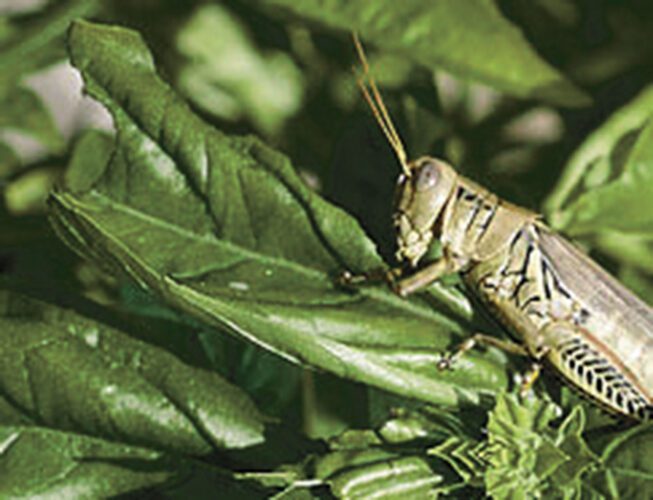What’s eating my plant?

An Eastern lubber grasshopper. UF/IFAS
Have you ever been leisurely strolling through your garden, admiring your handiwork and suddenly stopped short because you see a plant that is in distress? Perhaps you’ve seen pieces of the plant on the ground, or leaves that have holes or tears; and the worst case is a plant that appears to be defoliated overnight. Plant pests include non-beneficial insects and wildlife, and they can rapidly damage your landscape.
This month, I’ll discuss some of the more common insect pests and how to identify them through the damage they cause to your plants. Next month we’ll tackle the four-legged pest varieties!
The beautiful Florida climate that probably drew you here provides the perfect environment for our subtropical plants, but unfortunately it is equally supportive of insect pests. I always walk through the garden several times a week so that I can monitor insect pests; by frequently inspecting your plants you will be able to catch problems and deal with them before they get out of hand.
The various insect pests can be identified by the type of damage they cause to plants. Insects with chewing mouthparts will produce ragged edges, holes or other missing tissue on leaves or stems. Caterpillars and Eastern lubber grasshoppers are among the most common insects in this category. Insects such as aphids, scales, spider mites and whiteflies have piercing-sucking mouthparts. They are equipped with strong mandibles, or appendages similar to jaws that are used for biting, cutting or holding food. The damage these insects inflict will cause browning or yellowing of leaves, and possibly wilting. You can usually find evidence of these insects on the underside of leaves or on the newest growth of the plant.
Insects that are classified as “defoliators” feed rapidly and voraciously, and can almost strip a plant bare. Caterpillars are well-known defoliators since they represent the larval stage (think of a teenager!) in an insect’s life before it reaches adulthood. These caterpillars must rapidly consume large quantities of food prior to pupating, or forming a chrysalis or cocoon. I have observed Io moth caterpillars strip several branches of a standard hibiscus overnight in my garden. And, of course, we know what monarch butterflies do to milkweed! But monarchs are a beneficial insect and the gardeners who support them are thrilled when we see our milkweed plants defoliated.
Leafminers are the larvae of flies, moths, sawflies or other insects that produce tell-tale tunnels that appear as squiggly lines as they burrow into a plant’s leaves. One of the best known leafminers in Florida is the citrus leafminer, which is not only destructive to our citrus crops, but may also create openings that allow citrus canker to infest the tree.
Insects that are classified as “gall makers” insert part or all of their bodies into plant tissue (leaves, stems or twigs) to either feed or lay eggs, causing the tissue to swell into a “gall.” While galls can be caused by many organisms including bacteria, fungi, nematodes and mites, insects are the most common cause of galls. There are more than 2,000 types of gall-producing insects present in Florida; the majority are wasps or tiny flies. Well-known gall makers include blueberry gall midge larvae that burrow into leaves while feeding, Josephiella wasps that create galls on ficus trees and can cause severe damage, and sea grape blister galls, which are unsightly but harmless.
Wood/phloem borers cause damage by feeding on living wood, and can be classified as primary invaders which strike healthy trees, and secondary invaders which attack stressed, dying or dead trees. The larvae of these borers can cause extensive damage through burrowing or girdling the tree, weakening the trunk and creating openings for bacteria or disease to enter the tree.
Now that you’ve had an introduction to some of the damage you can expect to see from insect pests, you might be wondering how you will identify these pests. The answer is right at your fingertips! Landscape Pests is a mobile site developed by the University of Florida/IFAS (Institute of Food and Agricultural Sciences) that can help you identify common pests found here in Florida (http://pest.ifas.ufl.edu/). This app provides pictures of the pests, a description of the damage they cause, how to detect the pests and management suggestions. Landscape Pests is a wonderful mobile resource that will help you identify and control common pests and assist you in maintaining a balanced environment in your landscape.
Stay tuned next month for information on wildlife pests!
Cathy Dunn is a Lee County Master Gardener Volunteer and a member of the Garden Club of Cape Coral. Visit at gardenclubofcapecoral.com.



